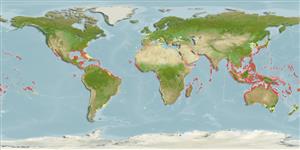Common names from other countries
Environment: milieu / climate zone / depth range / distribution range
экология
морской; мигрирует в океане (Ref. 51243); пределы глубины 0 - 20 m. Subtropical; 44°N - 36°S, 180°W - 180°E
Widespread in tropical and subtropical zones of all oceans including the western Mediterranean Sea and part of the Caribbean Sea (Ref. 3720), probably absent in the inland seas of southeastern Asia (Sulawesi Sea, Sulu Sea, Flores, Banda, Ceram and Halmahera seas (Ref. 27313)), and the Benguela Current (Ref. 4498). Eastern Pacific: Mexico to central Chile; also the Galapagos and Hawaii. Western Pacific: Japan, Marshall Islands, Philippines, Australia (Ref. 5530), and Tahiti.
Size / Вес / Возраст
Maturity: Lm ? range ? - ? cm
Max length : 30.0 cm TL самец/пол неопределен; (Ref. 9987); common length : 20.0 cm TL самец/пол неопределен; (Ref. 5217)
колючие лучи спинного плавника (общее число) : 0; членистые (мягкие) лучи спинного плавника (общее число) : 12 - 15; колючие лучи анального плавника: 0; членистые (мягкие) лучи анального плавника: 12 - 14; позвонки: 43 - 46. Body dark, iridescent blue above, silvery white below; pectorals and caudal fin greyish, other fins not pigmented (Ref. 2797). Juveniles with or without black bars (Ref. 2797). Branchiostegal rays: 9-11 (Ref. 36606).
Adults occur in surface waters, both near and far from the coast (Ref. 5217). Form schools. Capable of leaping out of the water and gliding for long distances above the surface. Feed mostly on crustaceans and other planktonic animals. Preyed upon by swordfish, tunas and many other larger pelagic fishes (Ref. 9987). Oviparous, with planktonic eggs and larvae (Ref. 36606).
Parin, N.V., 1996. On the species composition of flying fishes (Exocoetidae) in the West-Central part of tropical Pacific. J. Ichthyol. 36(5):357-364. (Ref. 27313)
Статус Красного Списка МСОП (Ref. 130435)
CITES (Ref. 128078)
Not Evaluated
Угроза для людей
Harmless
Использование человеком
рыболовство: коммерческий
дополнительная информация
инструменты
Специальные отчеты
Скачать в формате XML
ресурсы в Интернет
Estimates based on models
Preferred temperature (Ref.
115969): 23.2 - 29.2, mean 27.9 (based on 4828 cells).
Phylogenetic diversity index (Ref.
82804): PD
50 = 0.5312 [Uniqueness, from 0.5 = low to 2.0 = high].
Bayesian length-weight: a=0.00646 (0.00292 - 0.01429), b=3.04 (2.84 - 3.24), in cm Total Length, based on LWR estimates for this (Sub)family-body shape (Ref.
93245).
Trophic level (Ref.
69278): 3.0 ±0.09 se; based on food items.
устойчивость к внешним воздействиям (Ref.
120179): высокий, минимальное время удвоения популяции до 15 месяцев (Preliminary K or Fecundity.).
Fishing Vulnerability (Ref.
59153): Low vulnerability (20 of 100).
